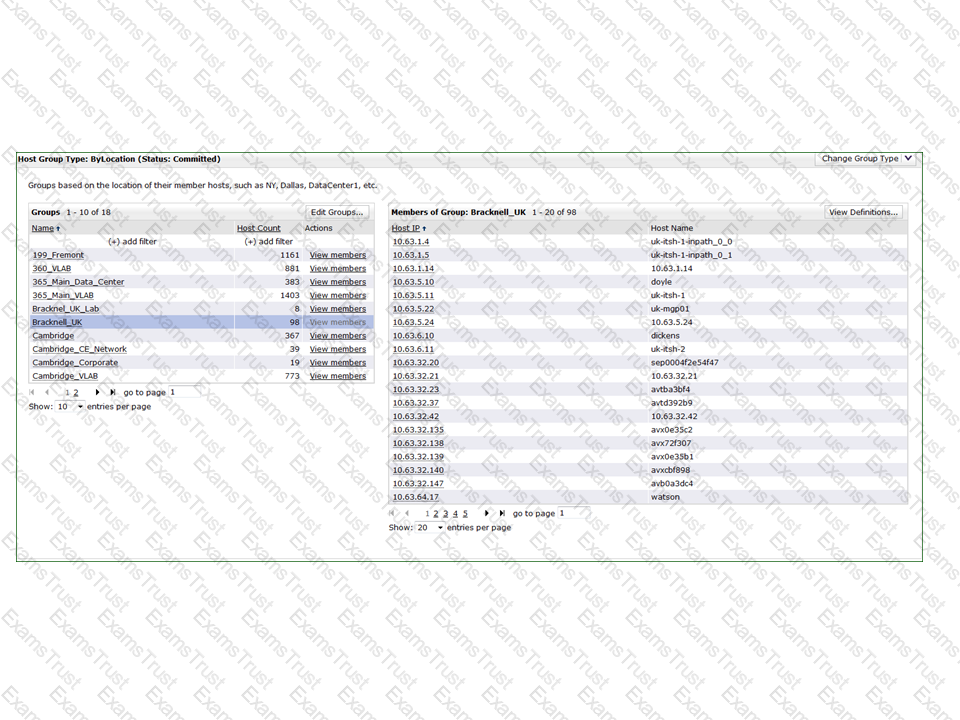The Cascade Profiler account roles arE. (Select 5)
Cascade Profiler is able to report traffic using two different approaches (centricities). Two approaches can result in different results when using the same report criteria due to the way data is aggregated and counted. What are these two approaches? (Select 2)
How does Cascade acquire the Interface Name (ifname) and interface speed (ifspeed) for interfaces reporting to Cascade?
For Service policies that get applied to End User segments, by default separate policies are tracked by location for the client traffic. Which of the following is NOT true regarding flexibility in configuration of these End User segments?
When sending data from a Gateway or Sensor to a Profiler which ports must be opened between the devices? (Select 3)
Can the same IP Address exist in Multiple Host Groups on Cascade Profiler?
What versions of NetFlow export the TCP flags?
What types of Layer-7 Application Signatures are available within the Cascade Profiler GUI? (Select 3)
For a TCP conversation that is non-optimized but being reported by a branch Steelhead appliance, the data center Steelhead appliance, and a data center Cascade Shark appliance, how is the Network RTT calculated?"
What is the maximum number of Cascade Profilers that can be configured in the Cascade Shark appliance as receivers of flows?
Which of the following will show a list of all NetFlow sources sending data to the Cascade system?
On Cascade Profiler, can you run a traffic report that shows all traffic from inside the network to outside the network, but excludes a proxy server?
What methodologies does the Cascade Profiler use to display MAC address information along with other host information?
Which of the following is false in regards to Cascade Profiler reporting and alerting? (Select 2)
Which of the following does the Cascade Sensor device provide that the Cascade Sensor-VE does not? (Select 2)
In Cascade Profiler, which of the following is available as a Dashboard content block? (Select 3)
Cascade Profiler Dashboard can be configured to show: (Select 3)
In the Cascade Profiler Dashboard GUI, which formats are available for Watched item content blocks? (Select 5)
How do I run a report on Cascade Profiler to show all hosts that have talked to server "192.168.1.100" on TCP port 25?
Within the Cascade Pilot GUI, filtered items are often indicated:
What are the sources of Layer7 Fingerprints as shown in the Cascade Profiler GUI? (Select 4)
Which of the following are TRUE concerning packet capture jobs on the Cascade Shark appliancE. (Select 4)
Which of the following capabilities are supported by the Cascade Sensor appliance but are not supported by the Cascade Sensor-VE RSP packagE. (Select 2)
On Cascade Profiler, in terms of retention of completed reports and reporting sources (one minute flow and rollup files), which of the following is true? (Select 4)
Cascade Profiler is reporting the traffic on Steelhead optimized flows separately than the connections on tcp/7800 between two Steelheads. In other words, from Cascade you see flows for traffic on various ports used natively by the clients and servers across the steelhead as well as flows for tcp/7800. What does this indicate?
A system administrator needs to update their Cascade Profiler host group settings to remove references to a decommissioned office on the 10.63.32.0/24 subnet.

What is the best way to do this?
The default group type for all Security Policies is:
If a report table on Cascade Profiler includes the "Server Delay" column but shows no value for "Server Delay" in some cells, what are the possible causes? (Select 3)
Why should all flow exporting devices use the same NTP (Network Time Protocol ) source?
Technologies used for switching traffic between Virtual Machines under ESXi include:
When defining a service which of the following are supported ways of aggregating the results? (Select 2)
Which of the following are valid syntax for host group definitions on Cascade Profiler? (Select 2)
What mechanism does Cascade Profiler use to identify the switch port a host is attached to and the hosts associated MAC address?
Which of the following is a valid group definition on Cascade Profiler? (Select 4)
What are the two types of dashboards available within the Cascade Profiler GUI? (select 2)
Simple Network Management Protocol can be used on Cascade Profiler for: